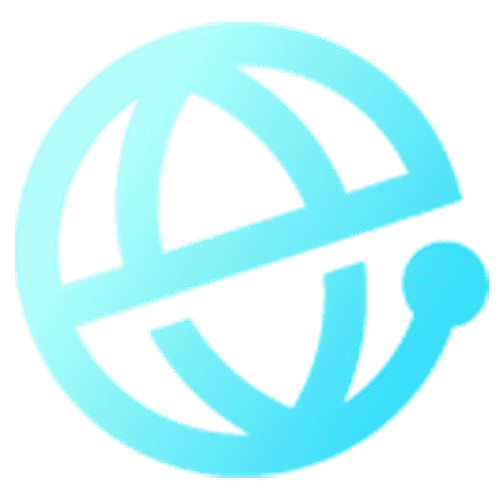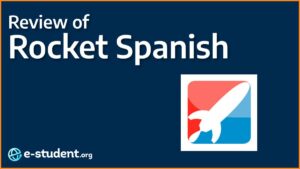For 2020-2021, Stanford University is ranked as 2nd in the World University Rankings. While the exact value of university rankings is up to debate, there is no denying the fact that Stanford University is one of the world’s most respected educational institutions.
Just take a look at the alumni list of Stanford:
- Herbert Hoover, the former President of the United States;
- Sergey Brin and Larry Page, the founders of Google;
- Marissa Mayer, CEO of Yahoo;
- Reese Witherspoon, the Academy Award-winning actress.
These are just a few examples of notable alumni of this renowned institution. The list of successful Stanford alumni is too long to be covered in detail in this post.
It is no wonder, then, that all degrees offered by Stanford come with heavy expectations and an even heavier price tag.
But, degrees are not what we are discussing here today. How do Stanford’s free online courses hold up to these high expectations?
In short, they do hold up. Stanford University has set an extremely high benchmark for all its online classes. They offer classes on some of the most current and captivating topics in the world. And nearly all the courses are presented by leaders in their respective fields.
This is why we felt it was beneficial for our readers to cover all the fantastic opportunities that lie within Stanford’s catalog of free online courses. Some of these classes are great for self-learning a subject from scratch, while others have some prerequisites as well. A common theme, however, is that they all offer a supreme online learning experience. As one would expect from Stanford University.
These are our picks for the ten best free Stanford online courses.
Best Free Stanford Online Courses
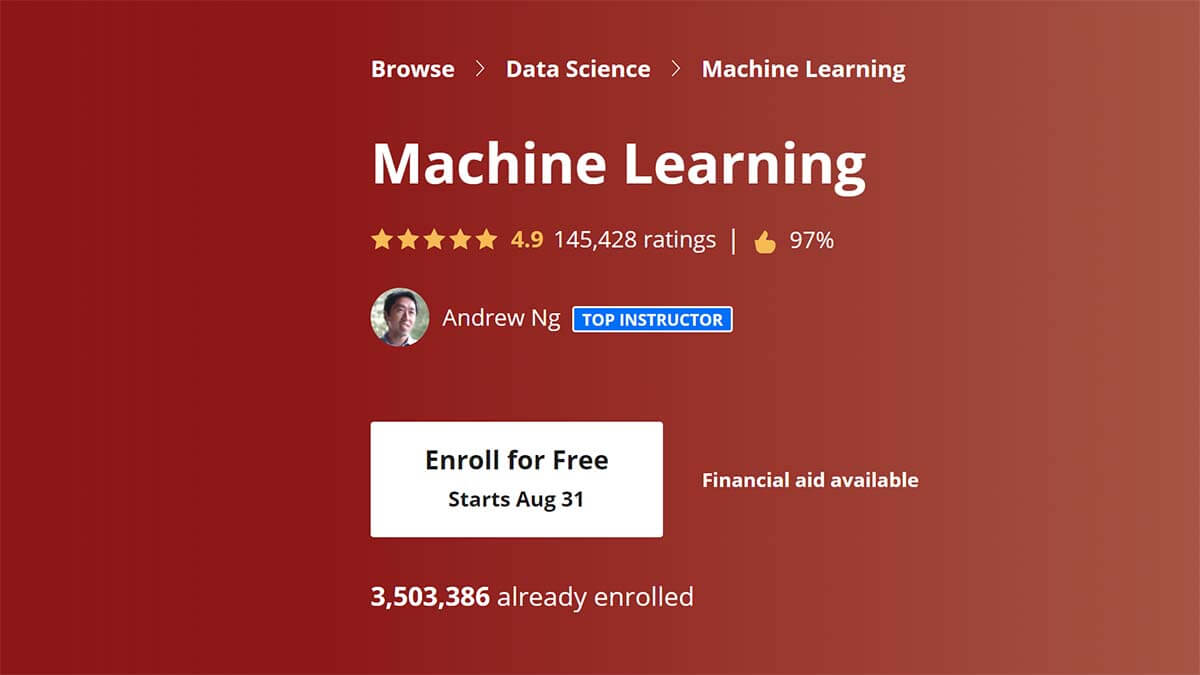
Machine Learning (Coursera x Stanford)
Ah, machine learning, the language of the future. One of the most relevant and captivating studies of the digital age. Unfortunately, there are several misconceptions about ML in certain circles. The most common one being that learning ML is nearly impossible without having a strong knack for numbers and technology.
This is flat out untrue. Yes, learning ML won’t come easy. You need to have patience, dedication, and a creative mind. But, as long as you have a strong interest in the subject, you do need to have the brain of Pythagoras or Marie Curie to succeed.
“Machine Learning” from Coursera and University of Stanford is the best introductory course to ML. Big words, yes, but this online class is truly praiseworthy.
The class is delivered by none other than Andrew Ng. For long-time readers of E-Student, Ng does not need a long introduction. He has dedicated his life to studying AI and has become one of the leading pioneers on the subject. Oh, and he also founded Coursera, one of the leading online learning platforms in the world. In short, for an introduction to ML, Ng is the best possible teacher.
The course itself is medium-length, taking about 54 hours in total to finish. The focus on this course is on the grand scheme of things. Here, you will get a well-constructed introduction to what ML is. You will also learn about the latest developments in the field. And, perhaps most importantly, you will learn how to think like an ML scientist.
Overall, this is a fantastic course for anyone interested in the theory behind ML. It is beginner-friendly, very engaging, and comes with a certificate from a leading university.
And, for those of you who got hungry for learning ML in-depth, E-Student has also compiled a list of the best machine learning courses.
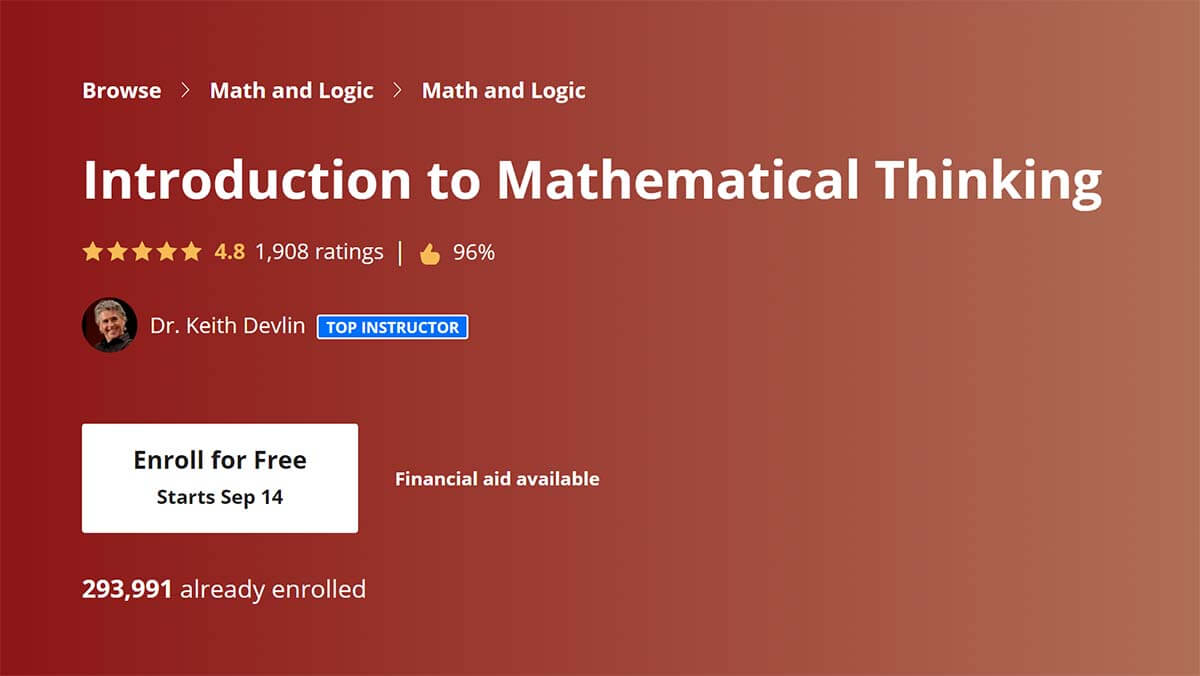
Introduction to Mathematical Thinking (Coursera x Stanford)
Before we dive deeper into this course, let me be clear on one thing. This Stanford online course is not like any other mathematics class you have ever taken.
As stated in the first module, to master your mathematical thinking, you need to “think outside the box.” Yes, a bit of a cliché. But when it comes to mastering mathematical thinking, it holds true.
So, what makes this course stand out among other free Stanford courses?
Well, for one, this just might be the most engaging mathematics course you will ever take. Dr. Keith Devlin is a rock star when it comes to math. He is one of the top instructors of Coursera for a clear reason. The teachings of Devlin are engaging, easy-to-follow, and full of high-quality content.
At times, the syllabus of this 40-hour class can be challenging. Yes, even for people who were strong in high school mathematics. But, as you know, nothing worth having comes easy. And, what is the point of an online course if the attendee does not feel challenged?
This class is not about stuffing your head with formulas. Instead, you will learn how formulas are formed. This is just one example, of course. But it is a great example to give you a general idea of the topics you can expect from this course.
Should one consider attending without an in-depth interest in numbers?
In short, yes.
Forget your number-related traumas from high school and look at the bigger picture. Courses such as these are fantastic for developing your analytical thinking. And, analytical thinking is key to being an integrated individual in the digital age. Both in your personal and professional life.

Writing in the Sciences (Coursera x Stanford)
Let’s continue with a fascinating course on writing. Scientific writing, to be more precise. I’m sure you all know the old cliché of the eccentric professor sitting behind a messy desk. Well, this is the course to help this professor become efficient in putting his ideas on paper.
Writing is commonly thought of as a solely creative pursuit. In reality, creativity is only half the battle. Technical writing skills are also extremely important. Especially when it comes to writing complex texts such as grant proposals or scientific articles.
This course from Dr. Kristin Sainani is a masterful resource for the technicalities of good writing. It is a medium-length course, taking approximately 30 hours to finish.
The syllabus of the course is meticulous, showing attendees all the knots and bolts of the craft. And, not only does it contain in-depth theory, but a great number of practical exercises as well. All to make your writing more clear and captivating. Simply put, by the end of this course, you will be a considerable wordsmith.
Yes, you CAN make any text engaging. Even articles about topics such as the reproduction of amoebas.
Despite the course being developed for scientific writing, nearly everyone can benefit from the teachings of Dr. Sainani. Strong writing skills are not only needed for putting together heavily scientific text. Editing and writing skills will also help you with, for example, creating a knock-out resume or writing a hall-of-fame worthy loan application.
In short, this is one of the most useful free Stanford courses out there. It is practical, relatively short, and highly engaging. This course is proof that anyone can master writing by learning the theory behind the craft.
And yes, that includes those of you who flunked their literature classes in high school.

Stanford Introduction to Food and Health (Coursera x Stanford)
We continue with one of the most useful Stanford online courses currently available. In fact, this nutrition course should be mandatory for anyone interested in preserving their health and well-being.
“Introduction to Food and Health” is a medium-length course, taking approximately 5 hours to finish.
It is a highly captivating course with a clear goal in mind. A goal to give attendees all the information they need in order to make better choices regarding their food. Yes, the internet is full to the brim with nutrition advice. Some good, some plain ridiculous. But, this is a course from Stanford University. You can be 100% sure that there is no fluff included here.
The instructor, Mrs. Maya Adam, has a very distinctive style of teaching. For one, she is clearly not afraid of being frank with her audience.
Her presentation is sobering right from the get-go, as Adam speaks about the global obesity epidemic we are facing.
Oh, and she manages to share these troubling facts without ever getting preachy. A common, somewhat annoying habit of many nutritional scientists.
As the course continues, Adam gives the students a detailed roadmap towards a healthier lifestyle. Differentiating between processed and non-processed foods. Sensible substitutions for your fat-dripping favorites. Healthy grocery shopping. These are just a few examples of the lessons taught in this online class.
If you eat, you should take this course. Simple as that. The course is not too long and is very easy-to-follow. And, in a mere five hours, you will get a great foundation for a lifetime of healthier living.
Not a bad trade of time and value, in my opinion.
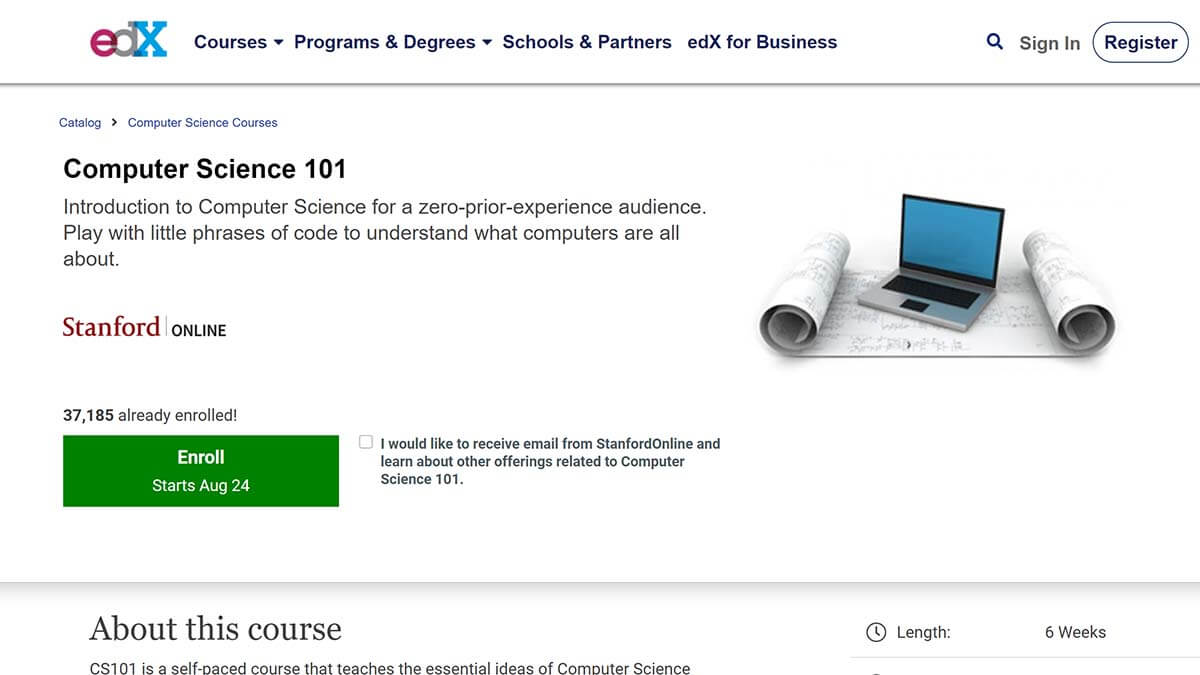
Computer Science 101 (edX x Stanford)
“Computer Science 101” from edX and Stanford University is a superb resource for everyone interested in computer science. It is a medium-length Stanford course, taking approximately six weeks to finish in full.
In this class, the focus is on the very essential topics of computer science.
This means that you will start right from the beginning, learning the nature of computers and coding. You will also be acquainted with all the relevant terms in computer science. And, most importantly, you will get your first practical experiences with coding.
The course is clearly developed with total beginners in mind. I would go as far as to say that there are resemblances to a high school computer class. But, this is not a bad thing. A bit of nostalgia is always nice.
And I know so many of you are interested in computer science, yet feel as if this field is somehow limited only for the “tech-brains.” This class proves that computer science is not nearly as inaccessible of a subject as some think.
The instructor, Nick Parlante, is a fantastic choice to lead such a class. His passion for the subject engages even the most computer-meek attendees.
To sum this up, this is one of the best introductory computer science courses out there. It is very beginner-friendly, yet highly detailed. Plus, the instructor is a rockstar when it comes to making difficult subjects understandable to beginners.
After enrolling, expect to be well-versed on the theory behind computer science. In addition, you will also know all the industry-relevant terms of computer science.
Simply one of the best computer science classes for beginners.
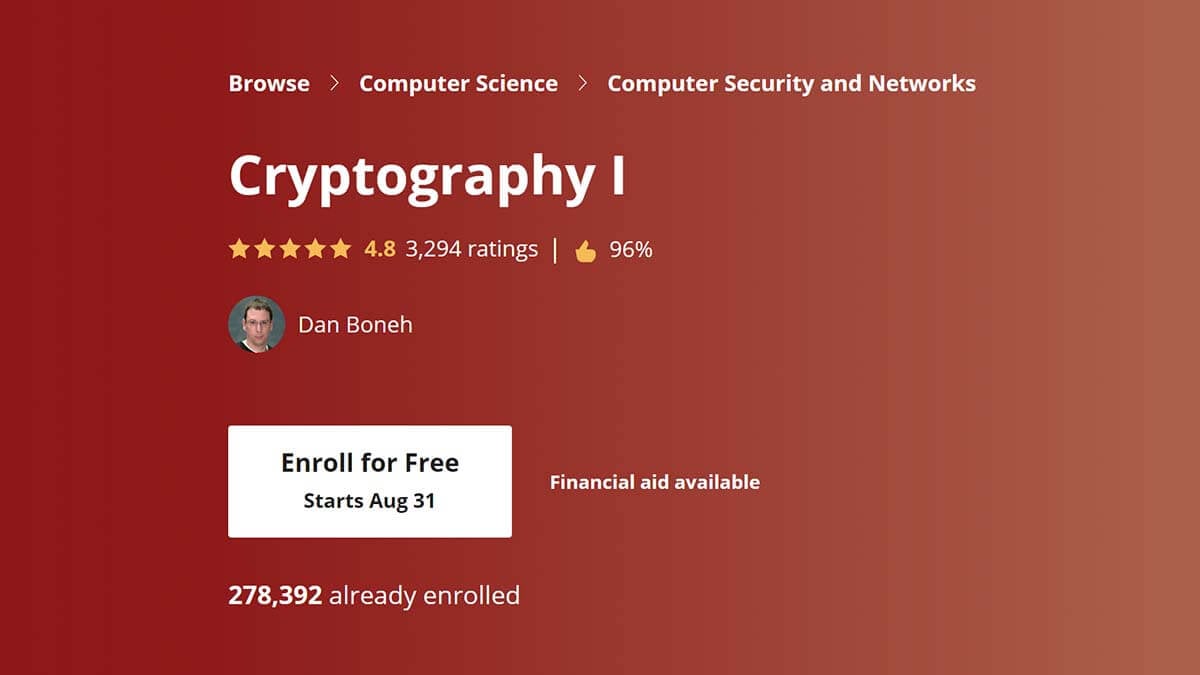
Cryptography (Coursera x Stanford)
Have you ever stopped to wonder just how dependent you are on various online transactions? In this day and age, most of us have highly personal information on various social media sites, browsing histories, and even shopping accounts. It is relatively strange, then, that so few of us stop to wonder about the safety of our online footprints.
This is one of the best free Stanford courses on cybersecurity. It is an eye-opening class for several reasons.
For one, you will see just how vulnerable your daily online interactions can be. And also how much hard work goes into protecting your valuable data.
The course itself is medium-length, taking approximately 20 hours to finish.
I wouldn’t recommend taking the course without a deep interest on the subject. The mathematical terminology could become quite heavy for casual viewing. This is one of the courses that require some dedication and effort on your part.
However, if you do feel confident about your mathematical mind, it is a fascinating class.
The instructor, Dan Boneh, starts the attendees off with the definition and history of cryptography. From there, the course wastes no time in getting into detailed case studies and advanced encryption methods.
This is one of the courses that heavily benefit from flexible deadlines. You will not be getting much from it by blowing through the material fast. Make sure to fully engage yourself and put full effort into understanding both the presented theory and practical lessons.
All in all, would I recommend taking this course?
Certainly.
Becoming aware of the idea behind cryptography is key to making more secure choices online. And, crimes such as online identity theft are alarmingly common. It is about time, then, that the general public became more aware of basic cryptography theory.
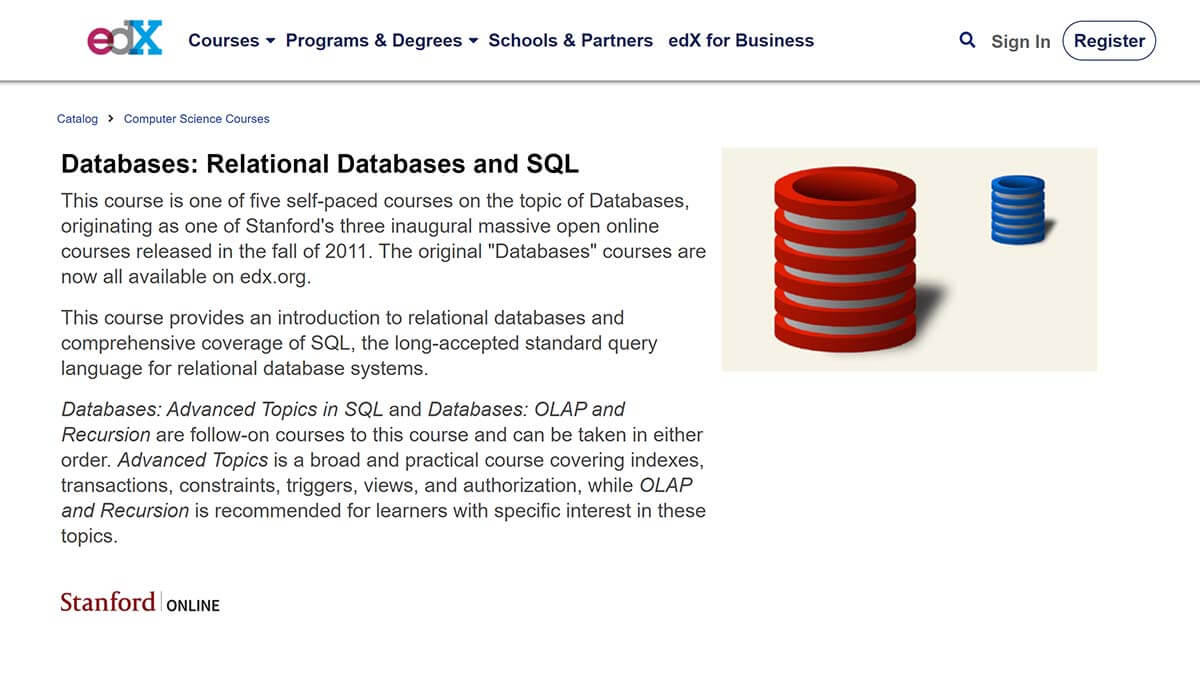
Relational Databases and SQL (edX x Stanford)
We continue with one of the most legendary Stanford online courses. “Relational Databases and SQL.” is one of the inaugural courses released by Stanford University in 2011. It is the first class in the five-part collection of courses on databases. And, it is by far the most popular of the series.
The popularity of this class is fully deserved. It is quite simply a fantastic entry for learning about relational databases and to become proficient in SQL.
So, why should one undertake learning databases? Good question.
Well, in the digital age, databases are everywhere. Quite literally. If your technology uses the same information constantly on a regular basis, it uses databases. It is no wonder then, that mastering databases are key to so many fields of tech.
For example, brilliant computer scientists often cite having a good understanding of databases as key to their success.
Let’s continue with a few words about the course itself. The course takes two weeks and is fully self-paced. It has no specific prerequisites. But, some background in computer science is still expected from the attendees.
Otherwise, you would just be hitting a brick wall instantly. Da Vinci didn’t start painting the Mona Lisa without knowing how to hold a brush.
However, if you do have a background or a strong interest in tech, this course would provide for a solid introduction to relational databases. The theoretical materials, quizzes, and exercises are all of supreme quality. And, for learners interested in going even more in-depth, there is a possibility of taking the additional four courses.
All in all, yet another solid course from Stanford University.
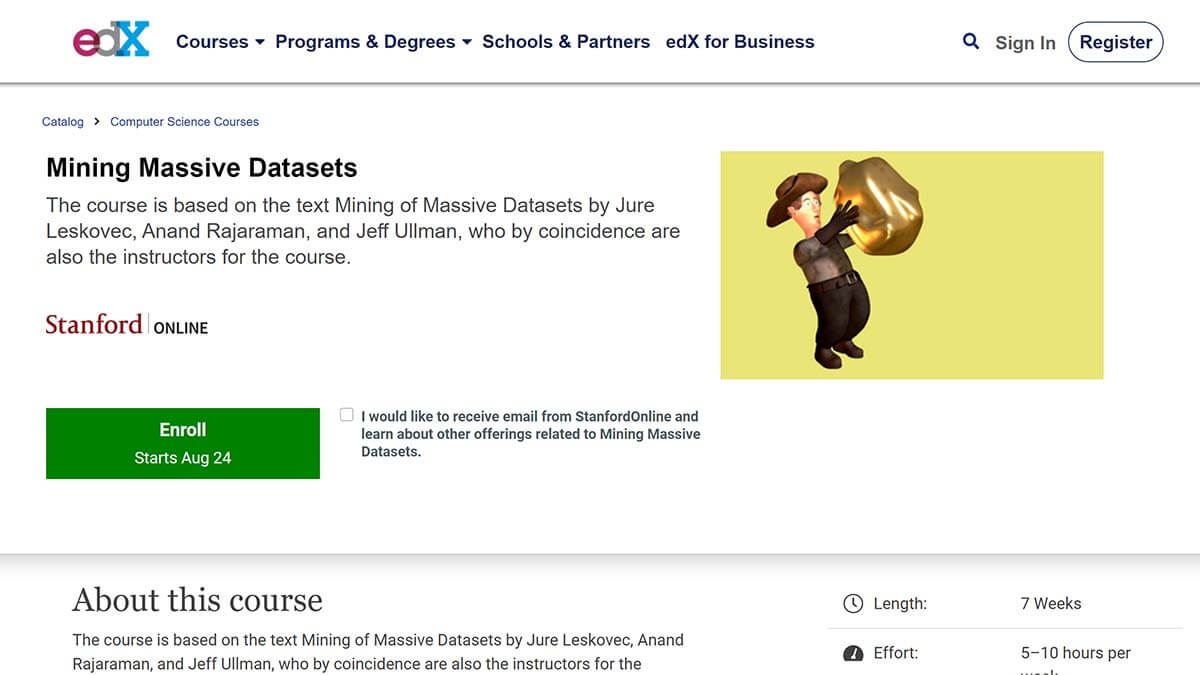
Mining Massive Datasets (edX x Stanford University)
We continue with another great Stanford course on data. Here, the focus is on data mining. Mining massive sets of data, to be more specific.
The course takes seven weeks to finish and is intended for graduate students and undergraduates in computer science. However, these prerequisites are not necessarily set in stone. If you have successfully enrolled in several online computer science classes, it is entirely possible that you already meet the criteria for this class.
As always, self-learning will take both time and effort. And, this course will challenge you at times. But, as you perhaps already know, efficient self-learning skills are absolutely crucial in modern computer science.
The course is based on “Mining of Massive Datasets”, a book by the authors of these video courses. Luckily, the book is freely available online. And for maximum efficiency, I would advise combining the text with the video lessons presented in this course. The two materials overlap fantastically. And, together, they make for one of the best online resources for dataset mining.
This is a fully practical course. So, do not expect to find debates on the ethics of data mining from this class. Instead, you will get a throughout tutorial on various mathematical and algorithmic ideas behind mining massive datasets.
As I mentioned in the overview of the previous course, mastering data-related topics are crucial in the tech world. So, yes, the materials are certainly worthy of the time investment. Especially if you are in the computer science field.
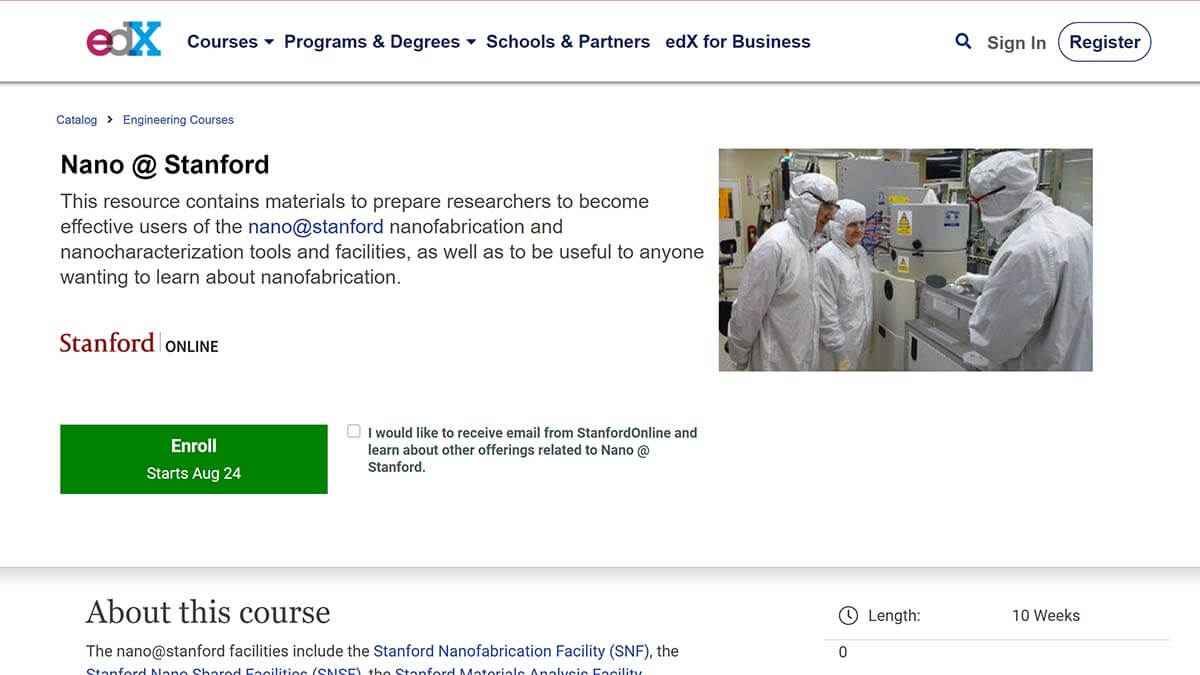
Nano @ Stanford (edX x Stanford)
Time to slip into a lab-coat!
This course from Stanford University is all about nanofabrication. Here, you will get a solid preparation for entering this highly fascinating and lucrative field. To be more specific, the course is put together to prepare the future students of the Stanford Nanofabrication Facility.
So, this raises a good question. Is it worthwhile to take this course if one is not planning on studying nanofabrication at Stanford?
In short, yes it is.
The course welcomes everyone interested in nanofabrication with open arms.
True, some lessons are tailored with Stanford equipment in mind.
However, the basic principles and concepts of nanofabrication are also taught in this class. And, as of 2020, Stanford is one of the leading universities in nanoscience. There is no better online resource to get familiar with the equipment and methodology used in nanofabrication!
So, even if you are planning on pursuing nanofabrication in a different establishment, this course will build a fantastic foundation.
The course itself takes approximately 10 weeks to finish. It is a fully self-paced course. A note of caution, though! Do not skip a single thing! Yes, that also goes for the topics that only focus on equipment found at Stanford. This is a science of nanometres. So, people who like to skip details will not get too far.
All in all, as far as nanofabrication courses go, this Stanford online class is splendid. It is highly detailed, practical, and contains up-to-date developments from this lucrative field. All from the world-leading research university on the subject.

Divide and Conquer, Sorting and Searching, and Randomized Algorithms (Coursera x Stanford)
We continue with yet another great free online course from Stanford University. Here, the focus is on algorithms. It is a medium-length course, taking approximately 13 hours to finish in full.
A note of caution, though. This is a laser-focused class that assumes the attendee to be quite well-versed in math. So, if you feel as if you are not an intermediate level math-head, expect to struggle.
However, if you already have some experiences with advanced math and programming, this is a terrific course to take.
The class is highly detailed, well-constructed, and full of practical lessons. Also, for a course on algorithms, it is surprisingly engaging. Who knew that learning QuickSort could be so fun?!
And, if you are planning on pursuing a future in tech, you won’t escape algorithms anyway.
So, you might as well get a head start and use this captivating course to educate yourself on the topic.
Mastering algorithms is so important that topic-related questions are one of the most common in tech-related job interviews.
So, nail these concepts down to a T and you are well ahead of the pack.
So, would I recommend taking this course?
Sure.
It is a rigorous, yet highly engaging class. And, for people operating in tech-related fields, these materials will prove to be extremely beneficial.
FAQs
Do Stanford online courses allow self-paced learning?
Yes, most of the Stanford courses allow students to set their own pace of learning. This is especially useful when it comes to highly detailed topics such as machine learning.
Is taking free Stanford online courses worth it?
Certainly. As mentioned in the introduction, Stanford offers high-quality online courses from a very broad amount of topics. You will certainly find a course to expand your intelligence and skills. And, as long-time online learners know, self-learning is immensely valued among modern employers. I am not exaggerating when I say that an online certificate could land you your dream job.
Do Stanford's free online courses give certificates?
Yes, the courses always come with a certificate that can be shared on your resume. Sometimes, however, issuing a Stanford certificate might incur some extra costs (though the course themselves are free).
